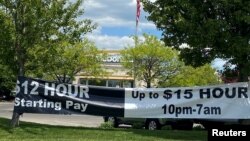First-time claims for U.S. unemployment compensation increased last week but remained near the low point during the 18-month coronavirus pandemic, the Labor Department reported Thursday.
A total of 332,000 jobless workers filed for assistance — up 20,000 from the revised figure of the week before. In part, benefit claims increased because Hurricane Ida’s drenching rains played havoc with the economy in the southern state of Louisiana.
Still, the claims figures for the last month have been on the whole the lowest since the pandemic swept through the U.S. beginning in March 2020, although they remain above the 218,000 average of 2019.
The jobless claims total has fallen steadily but unevenly since topping 900,000 in early January. Filings for unemployment compensation often have been seen as a current reading of the country’s economic health, but other statistics are also relevant barometers.
Even as the U.S. government said last month that its world-leading economy grew by an annualized rate of 6.6% in the April-to-June period, in August it added only a disappointing 235,000 more jobs. Economists said that figure was partly reflective of the surging delta variant of the coronavirus inhibiting job growth.
The number of new jobs was down sharply from the more than 2 million combined figure added in June and July. The unemployment rate dipped to 5.2%, which is still nearly two percentage points higher than before the pandemic started in March 2020.
About 8.7 million workers remain unemployed in the U.S. There are nearly 11 million available jobs in the country, but the skills of the available workers often do not match what employers want, or the job openings are not where the unemployed live.
The size of the U.S. economy – nearly $23 trillion – now exceeds its pre-pandemic level as it recovers faster than many economists had predicted during the worst of the business closings more than a year ago.
How fast the growth continues remains an open question.
For months, the national government had sent an extra $300 a week in unemployment compensation, on top of often less generous state aid, to jobless workers. But that extra assistance has now ended throughout the country. About 7.5 million jobless workers were affected by the cutoff in extra funding.
In addition, the delta variant of the coronavirus poses a new threat to the economy.
Political disputes have erupted in numerous states between conservative Republican governors who have resisted imposing mandatory face mask and vaccination rules in their states at schools and businesses, although some education and municipal leaders are advocating for tougher rules to try to prevent the spread of the delta variant.
U.S. President Joe Biden has ordered workers at companies with 100 or more employees to get vaccinated or be tested weekly for the coronavirus. In addition, he is requiring 2.5 million national government workers and contractors who work for the government to get vaccinated if they haven’t already been inoculated.
In recent weeks, about 150,000 new cases have been identified each day in the U.S., and more than 1,500 people are dying from COVID-19 daily.
More than 65% of U.S. adults now have been fully vaccinated against the coronavirus, and overall, 54.1% of the U.S. population of 332 million.
US Jobless Benefit Claims Increase, but Still Near Pandemic Low

WASHINGTON —







